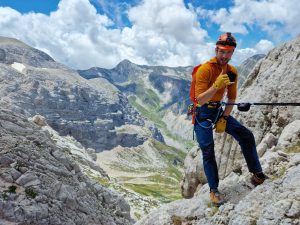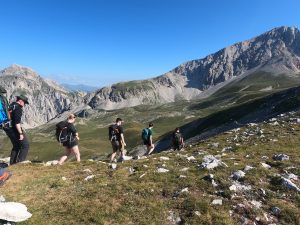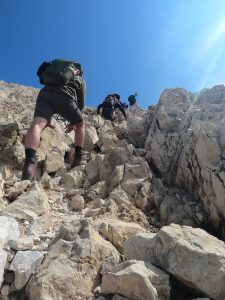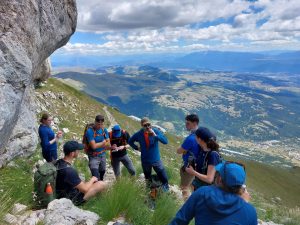East Scotland Universities Air Squadron Exercise Apennine Stag Post Exercise Report
Introduction
Adventurous Training (AT) as well as being fun and exciting, expands personal limits and improves operational capability because so many of the skills and characteristics it develops are directly transferable to frontline duties. However, AT comes at a price, especially if it is conducted overseas. To turn a dream into reality, you need a team of ambitious and determined people and a few supportive sponsors. Despite these challenges and the COVID restrictions that have overshadowed AT for several years now, a dedicated team of 8 young people and 2 staff instructors from the East of Scotland University Air Squadron (ESUAS), based at Leuchars Station in Fife, rose to the challenge. Turning to organisations who have had the vision and generosity to sponsor such activities in the past, ESUAS were able to reach their financial goals and turn their dream expedition into a reality.
Therefore, this post expedition report is written to express sincere thanks to the Ulysses Trust and Scotland’s Lowland and Highland Reserve Force Cadet Associations and our headquarters staff based at RAFC Cranwell. This report is also supported by a colourful PowerPoint presentation. It is hoped that we will be able to invite representatives from all our sponsors to visit our Squadron and receive this presentation from members of the group later this year. This will allow us to thank you in person and give you an opportunity to ask questions and learn more about what was achieved.
Planning
So, where should we go for our expedition and what activities should we include? These questions were posed about 18 months ago when COVID was still restricting movement. After a lot of discussion and brainstorming, it was decided that Italy should be the chosen location and summer mountaineering the chosen activity. This was partly because our Physical Training Instructor post was gapped, and we had other staff with experience of mountaineering in Italy who could step in to help. Most people think of the Dolomite mountains in the north of Italy, but a more accessible and equally challenging destination is the Apennine Mountain range located along the central spine of the country inland from Rome. More specifically, the Gran Sasso (Big Rock) national park and the summits of Corno Grande (Big Horn 2912m) and Corno Piccolo (Little Horn 2655m).
Goals
Both mountains were selected as the key summits to climb as they are almost at 10,000ft elevation and they offered the addition challenge of Via Ferrata routes. Via Ferrata literally translates to ‘Iron Road’ because it involves metal cables that are bolted onto the rock face to allow mountaineering to clip-in for protection and rapidly traverse exposed routes that would normally require slow paced rock climbing. Thus, enhancing the sense of exposure or ‘stretch’ whilst retaining protection from a fall.
Force Development
In addition to spectacular mountain scenery, the Gran Sasso also offers some incredible military history. For example, Mussolini was imprisoned in this mountain range during WWII and was subsequently rescued by a daring mission mounted. By the Germans called Operation Oak (Eiche) led by SS Captain Otto Skorzeny. So, the venue also provided some excellent Force Development case studies and the opportunity to shelter in Alpine Huts at altitude rather than camp in the lower, hotter valleys.
Outbound
In true military fashion the transportation departed Leuchars at 0200 meaning most people only had about 4 hours of sleep. Travelling at night was a first for many of the group who had not experienced travelling and operating whilst fatigued only to arrive in a foreign country with a different time zone, much hotter and more humid climate with different food and a different language. All experiences directly transferable to deploying on operations as a member of the UK armed forces. The next challenge was driving on the other side of the road around Rome on their version of the M25 where the only rule of driving is ‘there are no rules’. Thankfully, all our drivers had completed additional training in advance to prepare them for driving on the continent. They were able to negotiate the tolls and tunnels to safely find their way to our first destination, the hillside city of L’Aquila. A very basic motel with no air conditioning and temperatures above 30C but a welcomed shower and soft matress. After a hot night, we set off higher up the mountain range then left the cars parked and hiked onwards and upwards to our home for the next few night, the mountain hut called Refugio Duca degli Abbruzi (named after the famous Italian leader who was held prisoner nearby). The students had to carry 5 litres of water each at altitude which made them realise how thin the air was going to be for the next few days. The afternoon was spent summiting a nearby peak (Pizzo Cefalone 2533m) to gain further acclimatisation with the terrain, temperatures and altitude. Our bunk room was very cosy (cramped) each night and despite the snoring everyone was so exhausted they slept well.
“The driving alone has already put me in stretch and way out my comfort zone.” – OC A Peach.
Summit Day
After a morning health check and our daily risk assessment briefing, the group set off towards their main objective which was to summit Corno Grande. Each student was tasked with leading a short leg of the ascent to hone their mountaineering skills and give them a practical leadership opportunity. After many hours of ascent, the group reached their objective and added their names to the book which is kept at the summit in a large metal weatherproof box. Copious photographs were taken to mark the achievement and lunch was spent taking in the views and talking to local Italians who had ascended to the summit from a variety of directions. There was also an opportunity to look at what is left of the Corno Grande Glacier which has steadily shrunk over the last decade and may not last many more years sadly. The descent was full of conversation and the group were clearly on an adrenaline high having reached their objective and each having successfully navigating their own sections. Dinner was devoured in the mountain hut and the group reviewed what they had learned from the day on the exterior balcony taking in the panoramic views and watching a spectacular sunset.
“It feels really stressful having all eyes on you when you’re the one making the decisions that affect everyone but I think each time I had to make a decision it became less so than the last one” – OC F Renton
Theory Day
Due to a poor weather forecast which threatened thunder and lightning, a lower level safer route was chosen. This allowed the groups to recover somewhat from the previous day’s exertions and explore some of the local cliff-side villages. More importantly, due to there being no washing facilities in the mountain hut, other than a small hand-sink, the group used their tree-mounted camping shower bags to have a much needed clean up and hair wash al fresco. Each member of the group was also tasked with briefing a leadership topic prior to dinner and then each talked about a different aspect of Mussolini’s time in captivity, his rescue and ultimate demise using photographs of the local area where the mission was conducted and the plateau where the rescue gliders landed.
“Listening to the group discussions on leadership styles has made me think of people and managers I’ve worked with. Using the understanding of these models helps me pick attributes from the people I want for myself and avoid ones I don’t.” – OC K Stohrer
Iron Pathways
With a better weather forecast, the next day focussed on via ferrata and the smaller but much more technical summit of Corno Piccolo. The initial cable route was called Brizio which was an ideal route to introduce newcomers to the equipment, procedures and techniques required for safe via ferrata. This initial route finished at the foot of Corno Piccolo where a short food and water break was taken before ascending the next cable route called Danesi. A much more vertical route with very tall ladders to climb as well as metal step pinned into the cliff. The group performed very well encouraging and coaching each other over the more technical climbing sections which require guts and commitment to overcome the feeling of exposure. Their efforts were rewarded by spectacular views from the summit, but the subsequent descent took longer than expected due to the steep terrain. The hike back to the mountain hut was not a short one especially with all the extra weightof our via ferrata kit in our backpacks. However, the group returned just in time for dinner and enjoyed another beautiful sunset as we sat outside reflecting on the day and how much everyone had progressed in their skills and confidence in only a few days.
Descent
The final day on the mountains included a short walk to a nearby summit (Monte Aquila 2494m) then a few hours of packing and cleaning in preparation to walk out to the cars and drive back to Rome. After a well-deserved shower in our beltway motel, the group used the second half of the day to explore Rome and take in some of the magnificent historical landmarks and hearty Italian food.
“I’ve come to realise over the last few days that it’s less about leaving and returning to my comfort zone or bringing activities inside it, but expanding the boundaries of my comfort zone in order to create a wider area where I feel less mental stress from whatever it is I’m doing.” – OC W McMullan
Inbound
Next morning it was up and out to the airport for our 2-staged flight back to Edinburgh which included a short aircraft change in France’s Charles de Gaulle Airport. Thankfully, the cars were returned fuelled and scratch free and the student’s bags all passed the weigh-in check despite the paraphernalia they had purchased in Rome. Sadly, the group meal planned for the airport in France turned into a sprint from one terminal to the other due to flight delays and we boarded our final aircraft just as the gate doors were closing. Eventually, we all cleared customs back at Edinburgh and jumped in our minibus back to base arriving late and exhausted at 0100 ready for a good night’s sleep before returning our kit and heading home the next morning.
Summary
The overseas Adventurous Training expedition was a huge success and achieved all the aims with no injuries or incidents. The group memebers have all developed as individual and as team members and leaders. They have expanded their personal boundaries and were all taken out of their comfort zone and pushed into stretch at some point in the week. They are so proud of what they achieved and want to tell their fellow Squadron members about it and thank their sponsors in person. So, in conclusion, we would like to thank all our sponsors for their generosity and support. Without them, such an expedition would just not be possible.
The Officer Commanding ESUAS, Squadron Leader Campbell Blake, and the staff and students would like to thank the Ulysses Trust, the Highland and Lowland Reserve Force Cadets Associations in Scotland and the supportive staff based in headquarters in England, especially Mr Kev Thomson. We hope you will all be able to visit our Squadron soon to see our presentation and meet the team members face-to-face. Thank you.




